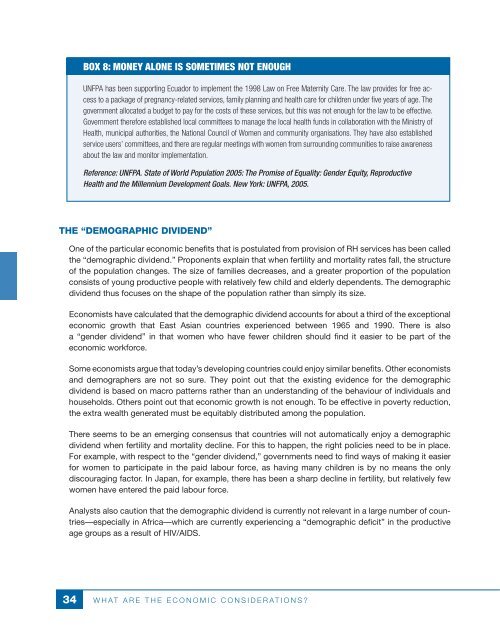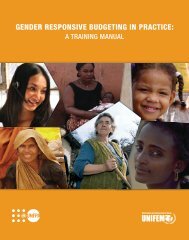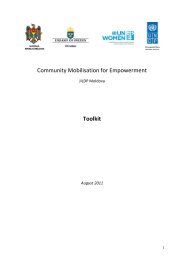Gender Responsive Budgeting and Women's Reproductive Rights ...
Gender Responsive Budgeting and Women's Reproductive Rights ...
Gender Responsive Budgeting and Women's Reproductive Rights ...
You also want an ePaper? Increase the reach of your titles
YUMPU automatically turns print PDFs into web optimized ePapers that Google loves.
Box 8: Money alone is sometimes not enoughUNFPA has been supporting Ecuador to implement the 1998 Law on Free Maternity Care. The law provides for free accessto a package of pregnancy-related services, family planning <strong>and</strong> health care for children under five years of age. Thegovernment allocated a budget to pay for the costs of these services, but this was not enough for the law to be effective.Government therefore established local committees to manage the local health funds in collaboration with the Ministry ofHealth, municipal authorities, the National Council of Women <strong>and</strong> community organisations. They have also establishedservice users’ committees, <strong>and</strong> there are regular meetings with women from surrounding communities to raise awarenessabout the law <strong>and</strong> monitor implementation.Reference: UNFPA. State of World Population 2005: The Promise of Equality: <strong>Gender</strong> Equity, <strong>Reproductive</strong>Health <strong>and</strong> the Millennium Development Goals. New York: UNFPA, 2005.The “demographic dividend”One of the particular economic benefits that is postulated from provision of RH services has been calledthe “demographic dividend.” Proponents explain that when fertility <strong>and</strong> mortality rates fall, the structureof the population changes. The size of families decreases, <strong>and</strong> a greater proportion of the populationconsists of young productive people with relatively few child <strong>and</strong> elderly dependents. The demographicdividend thus focuses on the shape of the population rather than simply its size.Economists have calculated that the demographic dividend accounts for about a third of the exceptionaleconomic growth that East Asian countries experienced between 1965 <strong>and</strong> 1990. There is also .a “gender dividend” in that women who have fewer children should find it easier to be part of theeconomic workforce.Some economists argue that today’s developing countries could enjoy similar benefits. Other economists<strong>and</strong> demographers are not so sure. They point out that the existing evidence for the demographicdividend is based on macro patterns rather than an underst<strong>and</strong>ing of the behaviour of individuals <strong>and</strong>households. Others point out that economic growth is not enough. To be effective in poverty reduction,the extra wealth generated must be equitably distributed among the population.There seems to be an emerging consensus that countries will not automatically enjoy a demographicdividend when fertility <strong>and</strong> mortality decline. For this to happen, the right policies need to be in place.For example, with respect to the “gender dividend,” governments need to find ways of making it easierfor women to participate in the paid labour force, as having many children is by no means the onlydiscouraging factor. In Japan, for example, there has been a sharp decline in fertility, but relatively fewwomen have entered the paid labour force.Analysts also caution that the demographic dividend is currently not relevant in a large number of countries—especiallyin Africa—which are currently experiencing a “demographic deficit” in the productiveage groups as a result of HIV/AIDS.34W h a t a r e t h e e c o n o m i c c o n s i d e r a t i o n s ?





